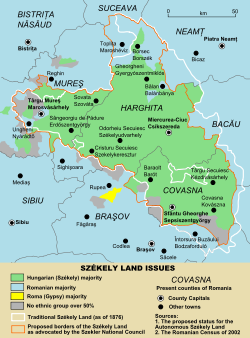
Székely autonomy initiatives
Encyclopedia

Székely Land
The Székely Land or Szekler Land refers to the territories inhabited mainly by the Székely, a Hungarian-speaking ethnic group from eastern Transylvania...
is a region of central Romania. According to official data from the Romania's 2002 census, 668,471 persons in Mureş
Mures County
Mureș is a county of Romania, in the historical region of Transylvania, with the administrative centre in Târgu Mureș.-Geography:The county has a total area of 6,714 km²....
, Harghita
Harghita County
Harghita is a county in the center of Romania, in eastern Transylvania, with the county seat at Miercurea-Ciuc.-Demographics:In 2002, it had a population of 326,222 and a population density of 52/km².*Hungarians- 85%...
and Covasna
Covasna County
Covasna is a county of Romania, in Transylvania, with the capital city at Sfântu Gheorghe.-Demographics:In 2002, it had a population of 222,449 and the population density was 60/km².*Hungarians – 73.79% *Romanians – 23.28%...
counties consider themselves Hungarian (the Székely speak Hungarian and are concentrated in these three counties). The most important political organisation of ethnic Hungarians in Romania is the Democratic Alliance of Hungarians in Romania, which undertakes to represent all Hungarians in Romania (i.e. not only those living in the Székely Land). This party assumes a somewhat cautious position and focuses on lobbying for an act on cultural autonomy.
Another Székely Land based organization, the Szekler National Council
Szekler National Council
The Szekler National Council is the main political organization representing the Székely of Romania.-History:The Council was founded on October 16, 2003. Its first president was József Csapó, who served until autumn 2006, when he resigned...
held a relatively large (4,000 to 10,000 people took part), peaceful demonstration in Odorheiu Secuiesc
Odorheiu Secuiesc
Odorheiu Secuiesc is the second-largest city in Harghita County, Transylvania, Romania. In its short form, it is also known as Odorhei in Romanian and Udvarhely in Hungarian...
on March 15, 2006, in favor of autonomy. . Five days before this, President Traian Băsescu
Traian Basescu
Traian Băsescu is the current President of Romania. After serving as the mayor of Bucharest from June 2000 until December 2004, he was elected president in the Romanian Presidential Elections of 2004 and inaugurated on December 20, 2004...
met with Jenő Szász (the mayor of Odorheiu Secuiesc and also president of the Hungarian Civic Union
Hungarian Civic Party
The Hungarian Civic Party is a political party of the Hungarian minority in Romania. It was founded in 2001 as the Hungarian Civic Union and was formally registered as a party on March 14, 2008...
), who assured the president of the peaceful character of the March 15 ceremonies and also briefly presented the UCM's vision on autonomy. On March 16 Băsescu visited the town and met with local and county officials. Băsescu declared that the Romanian administrative system should be more decentralized, but only in a symmetrical way, with no more autonomy given to the Székely Land than to any other region in Romania.
On February 12, 2007, Hungarian President László Sólyom
László Sólyom
László Sólyom is a Hungarian political figure, lawyer, and librarian who was President of Hungary from 2005 to 2010. Previously he was President of the Constitutional Court of Hungary from 1990 to 1998....
visited Romania and met Băsescu. The discussions included the controversial topics of minority rights and autonomy. Băsescu has pointed out that the situation of the Székely in Romania is in full compliance with the standards of the European Union
European Union
The European Union is an economic and political union of 27 independent member states which are located primarily in Europe. The EU traces its origins from the European Coal and Steel Community and the European Economic Community , formed by six countries in 1958...
. He also mentioned that a referendum for territorial autonomy would be illegal and characterized the Székely initiative not as a test of the public opinion, but as a test of Romanian laws. Romania's Interior Ministry has said that organizing an informal poll is not illegal.
Territorial autonomy for the Székely Land was supported by the former People's Action
People's Action (Romania)
The People's Action was a minor Romanian right-wing political party, founded and led by former President Emil Constantinescu. It had no seats in the Parliament of Romania nor in the European Parliament.In April 2008, it merged into the National Liberal Party....
Party, headed by former president Emil Constantinescu
Emil Constantinescu
Emil Constantinescu was President of Romania from 1996 to 2000.He graduated from the law school of the University of Bucharest, and subsequently started a career as a geologist...
.
Constitutional issues
Article 1 of the Romanian ConstitutionConstitution of Romania
The 1991 Constitution of Romania, adopted on 21 November 1991, voted in the referendum of 8 December 1991 and introduced on the same day, is the current fundamental law that establishes the structure of the government of Romania, the rights and obligations of the country's citizens, and its mode...
defines the country as a "sovereign, independent, unitary and indivisible national state." It has often been argued that, as a result of this provision, any ethnic-based territorial autonomy, including that of the Székely Land, would be unconstitutional.

